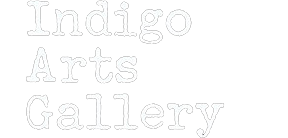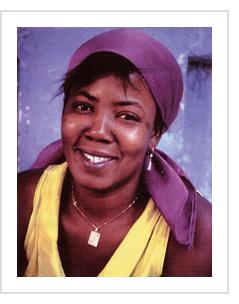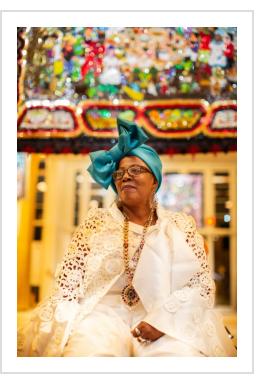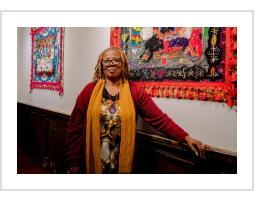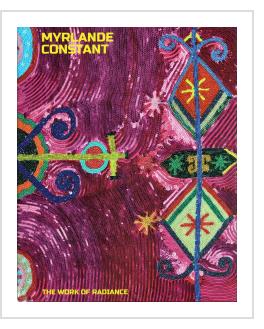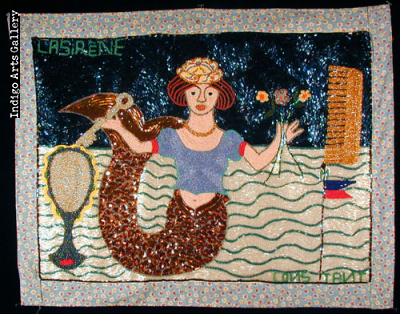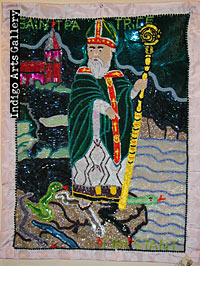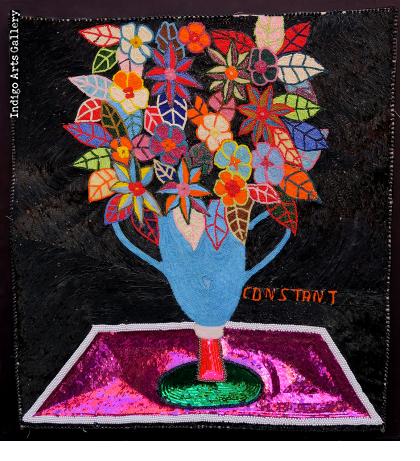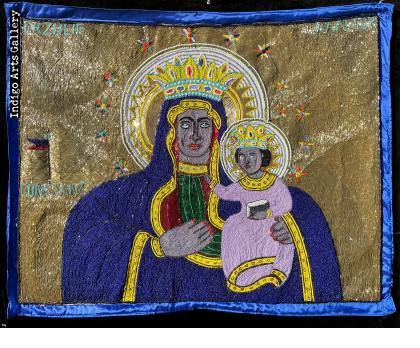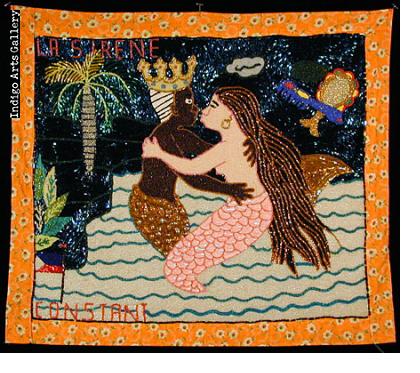About the Artist
Born in 1968 in Port-au-Prince, Haiti, Myrlande Constant is married and the mother of four children. She has been making flags since about 1990. Constant is the acknowleged leader of the new style of vodou flag artists, creating ornate and incredibly densely beaded flags, often much larger (some as large as six by seven feet!) than traditional flags. The flags are much more painterly than traditional flags, often showing side views ofm figures and even employing perspective. Though they depict the classic subjects of vodou flags, namely the lwas, they are often used and collected purely as art pieces. Constant learned the craft from her mother, who worked in a Port-au-Prince factory making beaded weding dresses. A number of women flag artists, including the late Amina Simeon, learned their craft at this wedding dress factory, which closed in 1988. (Biographical info adapted from the late Marilyn Houlberg's notes to show at Tap Tap Restaurant).
In April 2011 Myrlande Constant was featured in a major exhibit of Haitian Art at Brown University, entitled Reframing Haiti: Art, History and Performativity. As a guest artist Constant demonstrated her beading technique and engaged in a public discussiion with Wesleyan University anthropologist and poet Gina Athena Ulysse, who wrote an essay about Constant entitled Constant: Haiti's Fiercest Flag Bearer for the Huffington Post.
In 2018 Constant's drapo were featured in the groundbreaking Pòtoprens: The Urban Artists of Port-au-Prince exhibit at Pioneer works, in Brooklyn.
In December 2019 Constant's work was featured in the Faena Festival in Miami, which coincided with the annual Miami Basel art festival: A Haitian Artist’s Glittering Vodou Flags Steal the Show at Miami’s Faena Festival. Myrlande Constant: The Work of Radiance, a solo exhibition devoted to her work at the Fowler Museum at UCLA, opened in March, 2023.
Constant's biographical listing (by Katherine Marie Smith) in the Dictionary of Caribbean and Afro–Latin American Biography (Edited by Franklin W. Knight and Henry Louis Gates, Jr.) follows:
Constant, Myrlande Charles (1968–), Haitian textile artist, was born on 18 June 1968 in Port-au-Prince, Haiti, to Jeanne Constant and Jean Alfred Sanon. Constant was raised by her mother, a seamstress who worked in a factory that made wedding dresses and beaded appliqué. From a young age, Constant helped her mother with small beaded piecework that she would bring home from work. When she was 14, she began working in the same factory with her mother. She quit this job six years later, shortly before the factory closed, over a wage dispute with management. Constant married Wilfred Charles. Together, they had five children.
After Constant left her job at the factory, an artist friend encouraged her to try painting as a vocation. She was inspired to try “painting with bead,” as she describes her textile work. Constant began sketching Catholic saints on canvas and then beading the images. These images of saints are commonly recognized to also represent lwa (spirits) of the Afro-Haitian religion Vodou. For example, the first work that Constant sold was a portrait of Saint Patrick, who is recognized in Vodou as the spirit of snakes and ancestral wisdom.
Like many Haitians, Constant’s mother was pluralistic in her faith, identifying as Catholic while also serving the lwa. While Constant developed familiarity with Vodou as she grew up, when she began her career as an artist, she sought moreformal instruction from her father, a well-known ougan (Vodou priest) in the region of Léogâne. Her father’s instruction is reflected in her detailed depictions of rites, regalia, and myths associated with different lwa.
Constant’s use of beads and the intricately rendered content of her works are innovations to the existing tradition of drapo Vodou (Vodou flags). Vodou flags stem from a longer history of martial banners in the Atlantic world. Formally, many traditional flags resemble Napoleonic standards used in colonial Saint-Domingue (now Haiti) (Polk, 1997). Vodou temples commonly have a pair of flags that are used in important ceremonies to greet the lwa. Typically the most extravagant part of a temple’s regalia, flags may be embellished with sequins and embroidery. Since the mid-twentieth century, a handful of workshops in Port-au-Prince have also made flags as commodities for foreign tourist and art markets.
Flag artists typically supervise several apprentices who help execute their designs. Sometimes these apprentices go on to establish their own workshops and create their own artworks. When Constant opened her workshop, she employed former workers from the wedding dress factory. Some of her first employees have since gone on to become established artists working in the same technique. These artists include Roudy Azor, Amina Simeon, Mireille Delice, Evelyn Alcide, and Fils LaFleur (Josephson, 2007)
Vodou flags typically feature saints or a vèvè (a symbol representing a lwa) rendered in sequins. However, the technique of beading Constant learned in the factory and then introduced to the flag tradition allowed for greater possibilities of representation. She uses a technique called the “tanbou stitch” (drum stitch) because the fabric that the beads are sewn onto is stretched taut on a frame. Using beads, rather than sequins, allows for greater detail. Early in her career Constant realized that she could use this technique to make flags that conveyed narratives, elaborate rituals, and detailed homages to lwa. Her beaded works are much heavier and often larger than traditional sequined flags and are therefore not practical for use in ceremonies. Her works are still often referred to as drapo or flags, though some critics have questioned the appropriateness of these terms given their painterly quality and their distinctness from ceremonial forms (Polk, 2012).
As the scenes Constant depicted became more elaborate, she filled larger canvases. By the end of the 1990s, her works were much larger than traditional forms, at times exceeding 5 feet in length. Bitasyon (Familial Land), one of her largest works, is nearly 15 feet in length. It depicts a family’s ancestral homestead as it brings together the living and deceased to give thanks to their ancestral spirits under the canopy of a sacred mapou (silk cotton tree).
Before Constant began her career as an artist, male artists had dominated the commercial flag-making field. She was the first female textile artist to open a workshop and the first to gain international recognition for her work. Constant has spoken publicly about the role of other women in encouraging her work. She acknowledges her mother as her primary artistic and spiritual influence. Most of her earliest collectors and patrons were women. She credits the photographer Maggie Steber, filmmaker Kathleen Keen, and anthropologist and art historian Marilyn Houlberg for supporting her early in her career. Although her work has gained recognition abroad, she has stated publicly that she believes her work has not received greater support in Haiti because she is a woman.
Since the early 1990s, Constant has worked closely with Gallerie Bourbon-Lally in Pétionville, Haiti. Her work has been exhibited in Brazil, France, Jamaica, England, and the United States. In 2012 Constant was commissioned by the UCLA Fowler Museum and the Greene Foundation to complete a piece titled Haiti madi 12 janvye 2010 (Haiti, Tuesday, 12January 2010). This marked a new direction in her work because it addressed religious themes through the depiction of ahistorical event. Haiti madi 12 janvye 2010 measures roughly 8 feet by 8 feet, and portrays Port-au-Prince and its cemetery immediately after the earthquake of 2010 (Polk, 2012).
Bibliography
Josephson, Nancy. Spirits in Sequins: Vodou Flags of Haiti. Atglen, Pa.: Schiffer, 2007.
Polk, Patrick A. Haitian Vodou Flags. Jackson: University of Mississippi Press, 1997
Polk, Patrick A. “Remember You Must Die! Gede Banners, Memento Mori, and the Fine Art of Facing Death.” In In Extremis: Death and Life in 21st Century Haitian Art , edited by Donald J. Cosentino, pp. 115–142. Los Angeles: Fowler Museum at UCLA, 2012.
Smith, Katherine and Philogene, Jerry. Myrlande Constant: The Work of Radiance published by the Fowler Museum of Cultural History, UCLA, Los Angeles, 2022.
Ulysse, Gina Athena. “Constant: Haiti’s Fiercest Flag Bearer.”
A Haitian Artist’s Glittering Vodou Flags Steal the Show at Miami’s Faena Festival
An Artist Who Blends Secular and Sacred (With Sequins)
Myrlande Constant: Marshaling the Underworld
Fort Ganesvoort Gallery presents Myrlande Constant: Drapo
The Beaded Masterpieces of Myrlande Constant
Myrlande Constant: The Work of Radiance
Myrlande Constant exhibition honors the labor of working-class artists
Myrlande Constant Composes the Tapestries of Life
